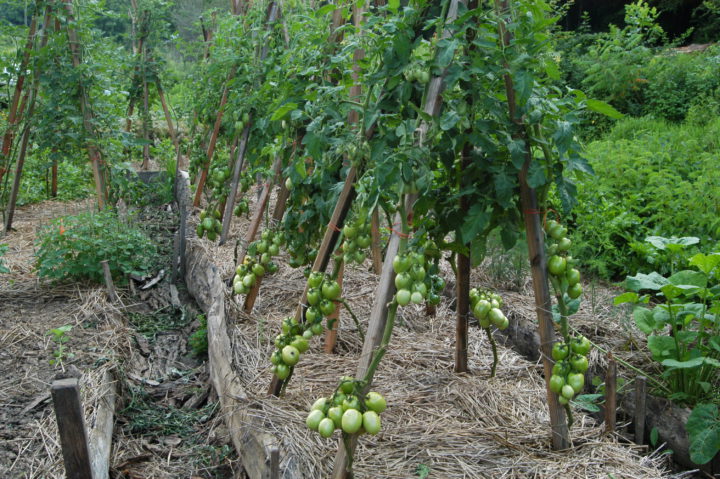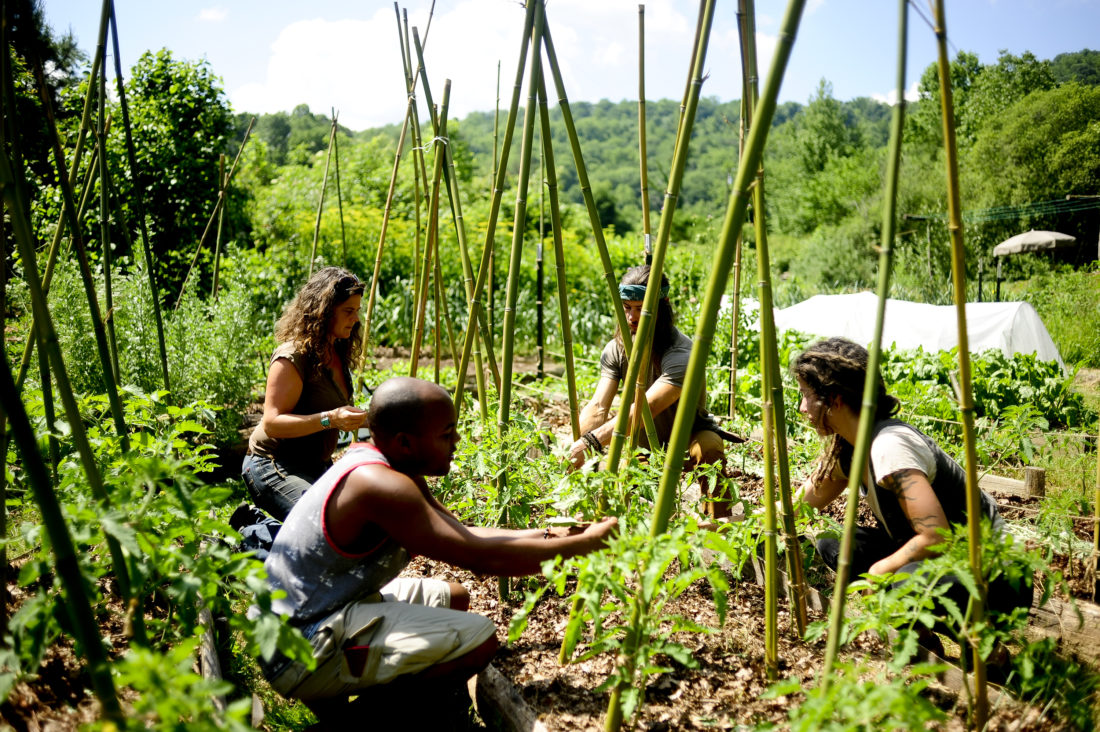Summer is here, but it barely feels like spring in many ways. We’ve had cooler-than-normal temperatures this year, which has been great for crops like lettuce and cilantro, and a little tricky for heat lovers like tomatoes, corn and peppers. In this month’s feature, I’ll troubleshoot the slow growth that you might be noticing, plus talk about trellising tomatoes. Be sure to send your questions for next month to me at gardening@mountainx.com.
How to juice growth
My summer crops like peppers, corn, tomatoes and eggplant are growing slower than usual. What can I do?
This spring has brought cooler-than-average temperatures to our mountains. We had a bit of a heat wave in early April, but since then we’ve had regular dips into the 50s and even 40s at night. Heat is one of the engines of growth for plants, and summer crops like those you mentioned need higher temperatures to grow, thrive and especially make and ripen fruits.
Some, including tomatoes, corn and squash, will simply grow more slowly in cooler conditions. Others, particularly eggplant, peppers, sweet potatoes and melons can be permanently stunted by those nights in the 40s. These extra-sensitive plants are better off planted later in the season, rather than risking getting chilled. If you’ve already got them in the ground and the temperature dips down, it’s worth getting out there and covering them to protect them from getting too cold.
Additionally, for all heat-loving crops that might be slowed by a cool spring, it’s essential to keep up with watering and fertility. These other essential elements of plant growth can’t make up for a lack of heat, but they give plants what they need to grow and can boost them as they withstand the stress of cooler weather. It’s easy to think we don’t need to water as much since it hasn’t been so hot and sunny. And while this is true to a degree, ample (but not excessive) watering is still important even though the weather hasn’t been so steamy. A good goal for most vegetables is to provide about 2 inches of water per week. This goes up if it’s hot and sunny and obviously includes any rain that might fall that week. For summer crops that are just getting established, it’s nice to water at least twice per week, spreading that amount out over time.
Along with water, growing plants need food. Nitrogen in particular helps fuel the kind of green growth that most summer crops are focused on at this time. You can supplement this nutrient in several ways. Powdered organic fertilizer blends like Plant-Tone are readily available and easy to use, and other options include feather meal, alfalfa meal and composted manure. There also are liquid fertilizers that you mix with water and use to “fertigate”; these include fish emulsion and urine (see more on fertilizing with urine here). With these measures in place, your summer veggies should still be able to produce, even in the face of our cool spring this year.
Containing unruly tomato plants
My tomato plants are like giant sprawling tarantulas. I’ve heard it’s important to prune and support them, but I don’t want to cut off branches that are making fruit and I don’t know what’s the best way to support them. Please help!
It makes total sense that your tomatoes are becoming tarantulas ― that’s part of how they naturally grow and spread. In fact, where their stems contact soil, they can grow adventitious roots. This means they can get more water and nourishment through these “backup” roots, or, if a vine breaks, it can make it on its own as a whole new plant. Additionally, when tomato fruits that are touching the ground rot, their seeds spread and make more tomato plants.
So, why do we want to give tomatoes a lift by staking or trellising? Well, because we have different goals for the tomato plants than they have for themselves. Our main objective is more sweet, juicy tomato fruits. Whereas their main goal (at least biologically; I’ve never been able to ask a tomato plant existential questions) is to perpetuate themselves as tomato plants.
When we stake tomatoes, we’re getting them to give us more of what we want. First, staking keeps the fruits from rotting on the ground. Also, picking is easier when fruit is elevated. Particularly in our warm, moist climate, lifting the plants allows for more airflow and less soil contact, which reduces fungal and other diseases. Staked tomatoes are trained to stay in their own space, not crowding their neighbors, and it’s easier to prune tomato plants that are staked. Finally, mulching is much easier under elevated plants.
Pruning helps with many of the aspects mentioned above, too. Plus, pruning makes staking or trellising easier. It may feel difficult to cut back a perfectly healthy-looking tomato vine (especially if you’ve let it grow long enough to make flowers or even fruits), but it will ultimately lead to healthier plants and higher yields in the long term.
Just like everything in the garden (and life), there isn’t just one way to support your tomato plants. When you’re deciding how to stake tomatoes, ask yourself these questions: How many tomato plants are you growing? Are your tomato varieties determinate (bushy) or indeterminate (tall, viney)? What materials do you have on hand? What’s your budget for staking tomatoes?
If you’re growing just a few tomatoes, any of the options below will do. But if you’ve got a big field of 10-plus plants, cages are probably impractical. When you’re dealing with determinate varieties of tomatoes, staking can be less beefy and cages more flimsy, whereas indeterminate varieties need strong support.
Lots of materials that you might have lying around could be helpful in staking tomatoes. Some examples are old pieces of wire fencing, bamboo poles, string, wire, even old pantyhose (to rip into strips and use to tie tomatoes to their stakes)! Things like T-posts and UV-resistant rope can be helpful but aren’t necessary if they’re beyond your budget.
Tomato cages
Tomato cages are those round wire contraptions you see for sale at garden stores. You also can make your own by rolling wire fencing into a cylinder. If you choose this option, make sure that there is room to get your hands through the fencing to prune and pick your tomatoes. Cages are ideal for smaller gardens (including tomatoes in pots), determinate varieties and in cases when a generally bushier growth habit is desirable. This means less airflow and more chance of fungal disease, but potentially more fruit per plant. Tomato cages are bulky and can be a pain to store. Homemade ones can be unrolled for easier storage. Using tomato cages to stake your tomatoes means the least amount of work tying plants onto their support throughout the season.
Wooden stakes (with optional tripod variation)
For this you will need tall (8 feet or more for indeterminate varieties) and stout (2-inch x 2-inch) poles or pieces of bamboo for each plant. Bury the end of the stake deep enough into the soil so it is stable. Use string or wire or strips of old pantyhose to tie the tomato plants to the stake.

You’ll need to prune off any suckers and maintain one central leader or “trunk” for this method to work. For extra strong stakes, set them up as tripods, with the tops fastened together and the buried ends at an angle.
String trellis
Tomatoes grown in greenhouses are most often supported by string trellises. However, this method of staking tomatoes can be used outside, too. In essence, it’s just like staking with wooden or bamboo stakes, but the string acts as the stake. Each tomato plant has a string coming down to it from a bar, wire or rope suspended above. Then, as the tomatoes grow, you simply twine them around the string in a spiral motion. There’s no need to tie the plants to anything with more string, which is handy. With this method, you’ll also need to prune off suckers and maintain a single leader or “trunk.”
The key to a good string trellis is to make sure it’s strong and secure. On our farm, we’ve used T-posts with stout bamboo poles attached to them to support a thick, UV-resistant rope. We anchor the rope at either end of the row with more T-posts, pounded at an angle, and tension it using a variation of the trucker’s hitch. Another friend uses the same vertical post system, with PVC plumbing Ts at the top and pieces or rebar going between vertical posts. If you have a greenhouse, you’ve already got a strong structure to work with.
Fence panel tomato trellis
So-called hog panels, or cattle panels, are sections of fencing made from thick, galvanized rods welded together. Flimsier “welded wire” fencing is also available, but it may flop over or sag when your tomatoes are juicy, ripe and heavy. To use this method, simply pound T-posts or wooden fence posts into your row of tomatoes and attach the fencing with string or wire. Then simply tie or weave your tomato plants onto the fencing as they grow. An advantage of this method is that you can choose to prune either for a central leader or for three or four leaders. In either case, you will still want to prune off subsequent suckers.



Before you comment
The comments section is here to provide a platform for civil dialogue on the issues we face together as a local community. Xpress is committed to offering this platform for all voices, but when the tone of the discussion gets nasty or strays off topic, we believe many people choose not to participate. Xpress editors are determined to moderate comments to ensure a constructive interchange is maintained. All comments judged not to be in keeping with the spirit of civil discourse will be removed and repeat violators will be banned. See here for our terms of service. Thank you for being part of this effort to promote respectful discussion.